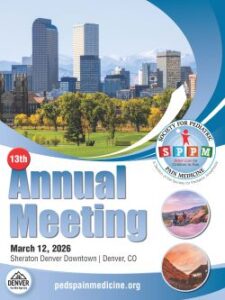A 30kg 8-year-old male with a history of Wilms tumor s/p right nephrectomy at age 5, postoperative nausea and vomiting (PONV), and burning chronic post-surgical pain (CPSP) at right abdominal incision site with numbness, presents for an elective outpatient umbilical hernia repair. The patient had been requiring opioids and gabapentin for his pain until 8 months ago when it resolved. The anesthetic plan includes preoperative acetaminophen, a general anesthetic including 1mcg/kg fentanyl, and post-induction, pre-incision bilateral rectus sheath blocks with 0.6mL/kg of 0.2% ropivacaine with 1:200k epinephrine. Given the patient’s history, which of the following preoperative medications is best suited to decrease postoperative pain and nausea / vomiting?
Correct!
Wrong!
Question of the Month - January 2025
 SPPM 13th Annual Meeting
SPPM 13th Annual Meeting